This review is made from a law enforcement point of view. I´ll concentrate mainly on practical use of the flashlight, and not so much on technical details.
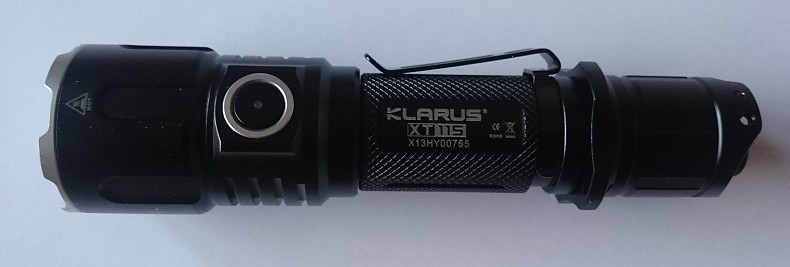
At first glance
Klarus XT11S has traditional tactical flashlight looks: the bezel ring is serrated, the bezel has a slight anti roll design and there are some cooling fins at the back of the bezel. The first differences compared to an average tactical flashlight are situated at the opposinmg sides of each other at the back of thje bezel: an additional operating switch which doubles as a charge status indicator, and a charging socket that is covered with a rubber blug.
The body of the flashlight is again of traditional variety. It is slightly knurled to prevent slipping. At the back of the body there is a removable pocket clip that enables the user to hang the flashlight the lens facing down. In my opinion, the flashlight is so large that it is better carried in a belt holster. There are situations, thought, when one can temporarily hang the flashlight from the edge of protective vest for example, to free both hands for something else. Behind the clip, there is a removable grip ring that can be used when using the flashlight with a handgun. In my opinion, though, the ring is placed too far back in the flashlight body to be comfortably used in Roger´s grip, for example. In addition to that, the grip ring is a bit loose and it rotates around the flashlight body. I did not find a way to fasten it tight enough to prevent rotating. However, I did not find this too distracting, and the user can easily remove the ring, if need be. There is a fastening hole in the grip ring for the wrist loop provided with the flashlight. Another fastening hole is located in the end cap.
The end cap is again traditional, apart from one thing. The rubber light switch is partially surrounded with a protective ring, so in theory when the user has his thumb on top of the protective ring, the light switch should not click on, at least not very easily. However, in this flashlight the light switch is too small and located off-center, that in practice the protective ring does not prevent the light going constant on very reliably.
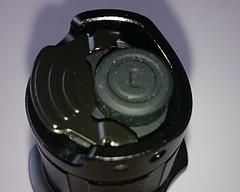
The reason why the light switch is located off-center is the main reason I became interested in this flashlight in the first place, and what makes is stand apart form other tactical flashlights: there is an additional, lever-like light switch located in the end cap of the flashlight. With this mode switch, one can for example turn on the strobe light, depending on the operating mode of the flashlight. More to come on this one.
In the retail packet, in addition of the flashlight itself, there were a 18650 battery, a charging cable, a wrist loop, some spare O-rings, and a belt holster. The charging cable is a standard USB - micro USB cable that enables the user to charge the flashlight from any USB port, or directly from a socket using an adapter that was not provided, but most users probably have lying around.

The belt holster provided with the flashlight is a traditional nylon flap holster. The belt loop is open and it attaches with a snap on button, with some additional Velcro to back it up. Therefore, one can place the holster on duty belt without removing all other stuff from the belt first, and one can also attach the holster to MOLLE webbing, as well. There is also a solid D-loop in the holster, so one can use it as an additional backing to attach the holster with flex-tie in case belt loop breaks open.
Using the flashlight
The flashlight has three operating modes: Classical tactical, Hunting / outdoors, and Assault. The flashlight operates slightly differently in all of the operating modes. The Classical tactical is the factory default, therefore it is used to explain the user interface.
The light switch is a forward clicky rubber switch. The user depresses the light partially down to operate the light momentary on, and for constant on, you just depress the light switch until it clicks. The light switch needs a pressure of some 750 grams (about 26,5 oz / 1,65 lbs) to operate the light momentary on, and some 1200 grams (42 oz / 2,6 lbs) for constant on; measured with a kitchen scale. The Mode switch is a bit stiffer yet, requiring some 1800 grams (63,5 oz / almost 4 lbs) of pressure. From a small sample, it seems that the normal starts from about 500 grams (17,5 oz / 1,1 lbs) and up, so this is a bit stiffer than normal. When used normally and the light switch is pressed with a thumb, the difference is barely noticeable, but when used in an unconventional grip like in syringe hold, the difference can be remarkable. For comparison, my all time favorite tactical flashlight (Insight Typhoon H2X) has a protruding, hard plastic knob as a light switch with a pressure of under 500 grams, and is is so smooth to operate that the flashlight is still my all time favorite in spite that the max light output is under 100 lumens. Anyway, the light switch acts as the main interface between the man and the machine, so the smoother it is, the better. The light switch in Klarus is not bad - far from it - but if I was to make one change in the flashlight, it would to make the light switch a bit lighter. Lighten up the light switch, if you like.
When you depress the mode switch, you´ll get an instant strobe light. The mode switch does not click on, but if you keep the mode selector depressed for two seconds, you´ll get an constant on Strobe that is deactivated my clicking the mode switch. If you press the mode switch shortly when the light is turned on, the light output goes from Turbo to High and then Low, and again to Turbo.
When clicking the side switch, the user can change the light output in the same way as when clicking the mode switch, but there is a Medium light output as well. When you press the side switch for a second when the light is turned off, you´ll get an instant Low light output, and if you click it rapidly twice, you´ll get a Strobe mode. Two additional clicks from strobe gives you an automatic SOS signal
With Hunting/outdoor mode the flashlight operates otherwise as described with Tactical mode, but when pressing the mode switch you´ll get an instant Low light output, instead of Strobe.
In the Assault mode, the flashlight operates as in Tactical mode, but the side switch does not function, and there is only Turbo light output available.
You switch between the modes by keeping the side switch depressed for ten seconds to get the flashlight into mode selection mode, keeping the side switch depressed and clicking the light switch until you´ll get the desired mode. The light blinks to show which mode is selected.
There is a lock out function in the flashlight, to prevent accidental activation. You lock the flashlight by keeping the side switch depressed for five seconds. The light blinks twice, and if you release the side switch at this point, the flashlight is locked out. If you keep the side switch depressed, the flashlight goes into mode selection mode, as described. You unlock the flashlight by rapidly clicking the side switch three times.
There is a battery charge indicator built in the side switch: when the light is turned on, the small LED in the side switch indicates the charge level of the battery. The same LED is used while charging the flashlight to indicate the status of the flashlight: charging iin progress, fully charged, or some problems with the charging.
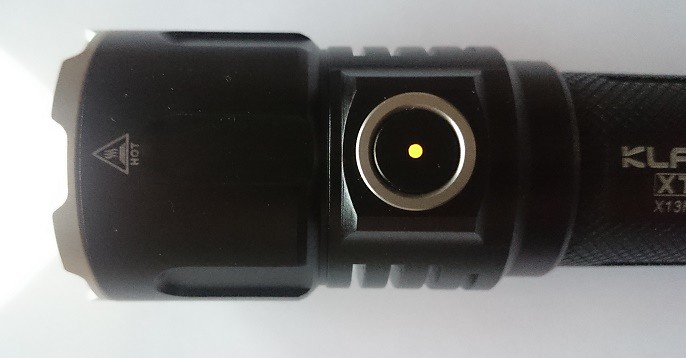
The flashlight can be operated with two CR123 batteries or with a single 18650 battery, which is provided with the flashlight. You can charge the battery either when removed from the flashlight in a charging dock, or inside the flashlight, using the charging port located on the back of the bezel of the light. The charging port is covered with a rubber plug, but only time will tell whether the plug starts to loosen up with use. The time it takes to charge the battery depends naturally on the capacity of the battery, but the battery provided with the flashlight takes some 3,5 hours to fully charge.
The light beam
The most important thing in a flashlight is the light beam - that´s the reason people carry flashlights around. Viewed from two feet or so, the Klarus has a slightly uneven light beam, but from normal lighting distances the shadows disappear, and the light beam is smooth and of high quality.
I measured the width of the light beam by attaching a tape measure in a wall, and lighting it up with the flashlight from a distance of one meter. The hot spot was about 0,2 meters, and the corona was about 1,0 meters. To determine the width of the light beam from various distances, simply multiply the distance with 0,2 or 1,0, respectively.
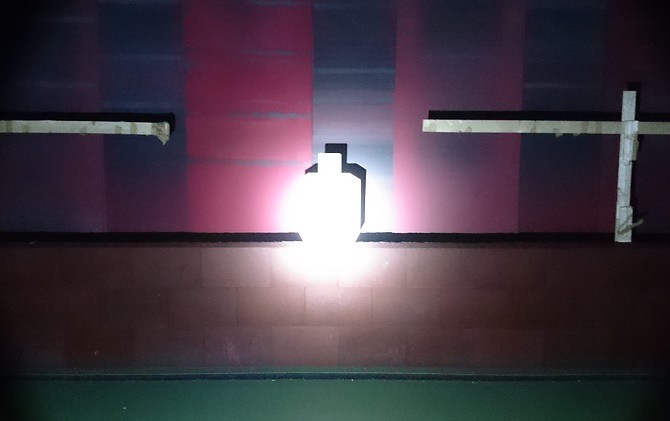
At 5 meters

at 25 meters
The max beam distance is 330 meters as stated by the manufacturer. However, per industry standard, this represents the distance where the light beam produces 0,25 lux of light which translates approximately the amount of light you get from a moonlight on a cloudless night. In my opinion, this is not practical level of lighting from a tactical flashlight, as it might be enough to notice a person, but it´s not enough to recognize him or determine, what object he has in his hands, for example. To determine the max practical distance, I illuminated the observation tower of Helsinki Olympic Stadium from various distances.

The tower is 72 meters (236 feet) high and the max distance where I could get useful illumination was about 180 meters (590 feet), making the total distance slightly over 190 meters (623 feet). So, the max practical beam distance in those circumstances was about 200 meters (656 feet).
Overall impression
Overall, the Klarus gives an impression of high quality and durability. As a minor downside is the grip ring that does not lock into place. It is a minor detail and does not affect the practical use of the flashlight, but still, it affects the overall impression. When it comes to functioning of the flashlight, it seems so reliable that I have no doubt it can be relied upon in serious social situations.
It remains to be seen, whether the rubber plug in the charging port will loosen up or not. The loosening is common with smartphones, but then you have to charge your phone on a daily basis, whereas you can go weeks without charging the Klarus - of course depending on how much you use it. Therefore. I ´m not too worried about the plug loosening. And it still is a great trade-off that you can charge the flashlight without removing the batteries. When the need arises, you just grab the flashlight and you are good to go in a second. And if you are worried about the plug loosening up, you just can charge the battery in a charging dock when removed from the flashlight.
The two operating switches in the end cap work pretty well, overall. Although it is a compromise, as the main light switch is not as big it could be, and sometimes the thumb accidentally finds its way to the Mode switch. On the other hand, in a quickly evolving situation the Strobe might work even better than regular light, so this probably is not a big issue, after all. The protective ring around the light switch does not protect the switch as well as in traditional, one-button light switches. Still, it is definitely a good thing that one can switch to Strobe instantly, and it makes the compromise worthwhile.
The light output and beam range are on the high end of the scale, in the category of tactical flashlights, which alone makes this an interesting flashlight. And in the end, it speaks volumes about the Klarus, that I placed it in my duty belt as my current primary flashlight.
Technical data
The data is mainly stated by the manufacturer.
Length: 13,9 cm (5,5 inches)
Weight including the battery: 162 grams (5,7 oz)
Circumference: 34,5 mm (bezel), 25,4 mm (body)
Light output / runtime:
- Turbo: 1100 lum / 2 hours
- High: 400 lum / 4 hours
- Medium: 100 lum / 18 hours
- Low: 10 lum / 260 hours
- Strobe: 1100 lum / 4 hours
- SOS: 100 lum / 64 hours
Max beam distance: 330 meters (1083 feet)
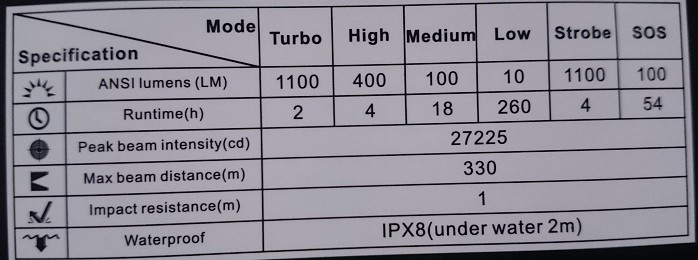

At first glance
Klarus XT11S has traditional tactical flashlight looks: the bezel ring is serrated, the bezel has a slight anti roll design and there are some cooling fins at the back of the bezel. The first differences compared to an average tactical flashlight are situated at the opposinmg sides of each other at the back of thje bezel: an additional operating switch which doubles as a charge status indicator, and a charging socket that is covered with a rubber blug.
The body of the flashlight is again of traditional variety. It is slightly knurled to prevent slipping. At the back of the body there is a removable pocket clip that enables the user to hang the flashlight the lens facing down. In my opinion, the flashlight is so large that it is better carried in a belt holster. There are situations, thought, when one can temporarily hang the flashlight from the edge of protective vest for example, to free both hands for something else. Behind the clip, there is a removable grip ring that can be used when using the flashlight with a handgun. In my opinion, though, the ring is placed too far back in the flashlight body to be comfortably used in Roger´s grip, for example. In addition to that, the grip ring is a bit loose and it rotates around the flashlight body. I did not find a way to fasten it tight enough to prevent rotating. However, I did not find this too distracting, and the user can easily remove the ring, if need be. There is a fastening hole in the grip ring for the wrist loop provided with the flashlight. Another fastening hole is located in the end cap.
The end cap is again traditional, apart from one thing. The rubber light switch is partially surrounded with a protective ring, so in theory when the user has his thumb on top of the protective ring, the light switch should not click on, at least not very easily. However, in this flashlight the light switch is too small and located off-center, that in practice the protective ring does not prevent the light going constant on very reliably.

The reason why the light switch is located off-center is the main reason I became interested in this flashlight in the first place, and what makes is stand apart form other tactical flashlights: there is an additional, lever-like light switch located in the end cap of the flashlight. With this mode switch, one can for example turn on the strobe light, depending on the operating mode of the flashlight. More to come on this one.
In the retail packet, in addition of the flashlight itself, there were a 18650 battery, a charging cable, a wrist loop, some spare O-rings, and a belt holster. The charging cable is a standard USB - micro USB cable that enables the user to charge the flashlight from any USB port, or directly from a socket using an adapter that was not provided, but most users probably have lying around.

The belt holster provided with the flashlight is a traditional nylon flap holster. The belt loop is open and it attaches with a snap on button, with some additional Velcro to back it up. Therefore, one can place the holster on duty belt without removing all other stuff from the belt first, and one can also attach the holster to MOLLE webbing, as well. There is also a solid D-loop in the holster, so one can use it as an additional backing to attach the holster with flex-tie in case belt loop breaks open.
Using the flashlight
The flashlight has three operating modes: Classical tactical, Hunting / outdoors, and Assault. The flashlight operates slightly differently in all of the operating modes. The Classical tactical is the factory default, therefore it is used to explain the user interface.
The light switch is a forward clicky rubber switch. The user depresses the light partially down to operate the light momentary on, and for constant on, you just depress the light switch until it clicks. The light switch needs a pressure of some 750 grams (about 26,5 oz / 1,65 lbs) to operate the light momentary on, and some 1200 grams (42 oz / 2,6 lbs) for constant on; measured with a kitchen scale. The Mode switch is a bit stiffer yet, requiring some 1800 grams (63,5 oz / almost 4 lbs) of pressure. From a small sample, it seems that the normal starts from about 500 grams (17,5 oz / 1,1 lbs) and up, so this is a bit stiffer than normal. When used normally and the light switch is pressed with a thumb, the difference is barely noticeable, but when used in an unconventional grip like in syringe hold, the difference can be remarkable. For comparison, my all time favorite tactical flashlight (Insight Typhoon H2X) has a protruding, hard plastic knob as a light switch with a pressure of under 500 grams, and is is so smooth to operate that the flashlight is still my all time favorite in spite that the max light output is under 100 lumens. Anyway, the light switch acts as the main interface between the man and the machine, so the smoother it is, the better. The light switch in Klarus is not bad - far from it - but if I was to make one change in the flashlight, it would to make the light switch a bit lighter. Lighten up the light switch, if you like.
When you depress the mode switch, you´ll get an instant strobe light. The mode switch does not click on, but if you keep the mode selector depressed for two seconds, you´ll get an constant on Strobe that is deactivated my clicking the mode switch. If you press the mode switch shortly when the light is turned on, the light output goes from Turbo to High and then Low, and again to Turbo.
When clicking the side switch, the user can change the light output in the same way as when clicking the mode switch, but there is a Medium light output as well. When you press the side switch for a second when the light is turned off, you´ll get an instant Low light output, and if you click it rapidly twice, you´ll get a Strobe mode. Two additional clicks from strobe gives you an automatic SOS signal
With Hunting/outdoor mode the flashlight operates otherwise as described with Tactical mode, but when pressing the mode switch you´ll get an instant Low light output, instead of Strobe.
In the Assault mode, the flashlight operates as in Tactical mode, but the side switch does not function, and there is only Turbo light output available.
You switch between the modes by keeping the side switch depressed for ten seconds to get the flashlight into mode selection mode, keeping the side switch depressed and clicking the light switch until you´ll get the desired mode. The light blinks to show which mode is selected.
There is a lock out function in the flashlight, to prevent accidental activation. You lock the flashlight by keeping the side switch depressed for five seconds. The light blinks twice, and if you release the side switch at this point, the flashlight is locked out. If you keep the side switch depressed, the flashlight goes into mode selection mode, as described. You unlock the flashlight by rapidly clicking the side switch three times.
There is a battery charge indicator built in the side switch: when the light is turned on, the small LED in the side switch indicates the charge level of the battery. The same LED is used while charging the flashlight to indicate the status of the flashlight: charging iin progress, fully charged, or some problems with the charging.

The flashlight can be operated with two CR123 batteries or with a single 18650 battery, which is provided with the flashlight. You can charge the battery either when removed from the flashlight in a charging dock, or inside the flashlight, using the charging port located on the back of the bezel of the light. The charging port is covered with a rubber plug, but only time will tell whether the plug starts to loosen up with use. The time it takes to charge the battery depends naturally on the capacity of the battery, but the battery provided with the flashlight takes some 3,5 hours to fully charge.
The light beam
The most important thing in a flashlight is the light beam - that´s the reason people carry flashlights around. Viewed from two feet or so, the Klarus has a slightly uneven light beam, but from normal lighting distances the shadows disappear, and the light beam is smooth and of high quality.
I measured the width of the light beam by attaching a tape measure in a wall, and lighting it up with the flashlight from a distance of one meter. The hot spot was about 0,2 meters, and the corona was about 1,0 meters. To determine the width of the light beam from various distances, simply multiply the distance with 0,2 or 1,0, respectively.

At 5 meters

at 25 meters
The max beam distance is 330 meters as stated by the manufacturer. However, per industry standard, this represents the distance where the light beam produces 0,25 lux of light which translates approximately the amount of light you get from a moonlight on a cloudless night. In my opinion, this is not practical level of lighting from a tactical flashlight, as it might be enough to notice a person, but it´s not enough to recognize him or determine, what object he has in his hands, for example. To determine the max practical distance, I illuminated the observation tower of Helsinki Olympic Stadium from various distances.

The tower is 72 meters (236 feet) high and the max distance where I could get useful illumination was about 180 meters (590 feet), making the total distance slightly over 190 meters (623 feet). So, the max practical beam distance in those circumstances was about 200 meters (656 feet).
Overall impression
Overall, the Klarus gives an impression of high quality and durability. As a minor downside is the grip ring that does not lock into place. It is a minor detail and does not affect the practical use of the flashlight, but still, it affects the overall impression. When it comes to functioning of the flashlight, it seems so reliable that I have no doubt it can be relied upon in serious social situations.
It remains to be seen, whether the rubber plug in the charging port will loosen up or not. The loosening is common with smartphones, but then you have to charge your phone on a daily basis, whereas you can go weeks without charging the Klarus - of course depending on how much you use it. Therefore. I ´m not too worried about the plug loosening. And it still is a great trade-off that you can charge the flashlight without removing the batteries. When the need arises, you just grab the flashlight and you are good to go in a second. And if you are worried about the plug loosening up, you just can charge the battery in a charging dock when removed from the flashlight.
The two operating switches in the end cap work pretty well, overall. Although it is a compromise, as the main light switch is not as big it could be, and sometimes the thumb accidentally finds its way to the Mode switch. On the other hand, in a quickly evolving situation the Strobe might work even better than regular light, so this probably is not a big issue, after all. The protective ring around the light switch does not protect the switch as well as in traditional, one-button light switches. Still, it is definitely a good thing that one can switch to Strobe instantly, and it makes the compromise worthwhile.
The light output and beam range are on the high end of the scale, in the category of tactical flashlights, which alone makes this an interesting flashlight. And in the end, it speaks volumes about the Klarus, that I placed it in my duty belt as my current primary flashlight.
Technical data
The data is mainly stated by the manufacturer.
Length: 13,9 cm (5,5 inches)
Weight including the battery: 162 grams (5,7 oz)
Circumference: 34,5 mm (bezel), 25,4 mm (body)
Light output / runtime:
- Turbo: 1100 lum / 2 hours
- High: 400 lum / 4 hours
- Medium: 100 lum / 18 hours
- Low: 10 lum / 260 hours
- Strobe: 1100 lum / 4 hours
- SOS: 100 lum / 64 hours
Max beam distance: 330 meters (1083 feet)

Last edited:

